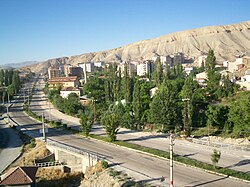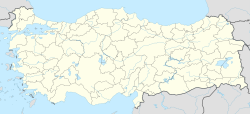world.wikisort.org - Turkey
Darende (Turkish: Darende [daɾændæ] (![]() listen)) is a district in Malatya Province, Turkey. The district lies 46 miles (74 km) to the northwest of Malatya,[5] 87 miles (140 km) south of Sivas,[6] 110 miles (117 km) east of Kayseri.[7]
listen)) is a district in Malatya Province, Turkey. The district lies 46 miles (74 km) to the northwest of Malatya,[5] 87 miles (140 km) south of Sivas,[6] 110 miles (117 km) east of Kayseri.[7]
Darende | |
|---|---|
 | |
 Darende | |
| Coordinates: 38°32′50″N 37°30′40″E | |
| Country | |
| Province | Malatya |
| Government | |
| • Mayor | İsa Özkan[1] (AKP) |
| • Kaymakam | Malik Çalışır[2] |
| Area | |
| • District | 1,362.62 km2 (526.11 sq mi) |
| Elevation | 958 m (3,143 ft) |
| Population (2012)[4] | |
| • Urban | 9,764 |
| • District | 29,386 |
| • District density | 22/km2 (56/sq mi) |
| Post code | 447xx |
| Website | www.darende.bel.tr |
History
Darende had been known by various names including Taranda/Daranda,[8] and Derindere.[9] It has been presumed that the district had been inhabited since 7000-5000 BC[10][9] due to the estimations made for the nearby archaeological sites such as Arslantepe[10] and Cafer Höyük.[11]
![Hittites lion statues[12]](http://upload.wikimedia.org/wikipedia/commons/thumb/4/48/Arslantas-Darende8.jpg/220px-Arslantas-Darende8.jpg)
The first known administrative unit in Darende was reportedly established by Hittites.[9] One of the Hittites remains within the district is a pair of lion statues residing around Arslantaş region, the west of Darende.[12] In chronological order, the governance to date was controlled by Hittites, Mitanni, Assyrians, Achaemenids, Romans, Byzantines, Umayyads, Abbasids, Seljuks, Danishmends, Rum Seljuks, Ilkhanates, Eretnids, Dulkadirids, Mamluks and Ottomans.[9]
Due to the configuration of the natural canyons surrounding the district (e.g. Tohma Canyon), the district has been reported to be one of the hops residing on trade, migration and military routes connecting various neighbouring regions; as an example, Šuppiluliuma I, who expanded Hittites across the Mediterranean and the Mesopotamia against Egyptian Empire, had been using the district to access the south,[13] and Basil I had been carried out his expeditions against Muslims over the district.[14]
During the Roman reign of 200 AD, Darende was one of the Roman settlements[15] which was deduced from the records that the Roman Emperor Trajan had transformed the neighbouring encampment of Melitene into a municipium against the Parthian Empire during the same period.[16] One of the Roman sites within the district is the Ozan Monument[17] which is a single-chamber mausoleum dating back either 200 AD[16] or 50 AD,[18] presumably a popular monument style in Anatolia during the Hellenistic Period.
Early Muslim conquests reached the region during Caliph Omar's reign and the district was conquered by Habib ibn Maslama for a short period of time, and it was reconquered by the same commander during Mu'awiya I's reign around 653-654.[19] Between 7th and 12th centuries, the administration of the district had changed hands rather frequently; however, Darende seems not to be noted until, for the first time, Taranta had been registered as a bishop under the metropolitan bishop of Melitene in the 13th Notitiae Episcopatuum (12th century).[19]
Demographics
Evliya Çelebi claimed that the town's population was wholly made up of Armenians and Turkomans at the time of his travels.[20]
Culture
Folk music
A metadata analysis on Turkish folk music in Darende has reported twelve ballads of the district:[21]
| Ballad | Turkish makam | Compiler |
|---|---|---|
| Arpa derdim süt iken | Hüseyni | Muzaffer Sarısözen |
| Çık daldan erik devşir | Uşşâk | Nazmi Özalp |
| Değirmenin postu dar | Hüseyni | Muzaffer Sarısözen |
| Değirmen üstü çiçek | Muhayyer | Ahmet Yamacı/Turhan Karabulut |
| Dereden duman galktı | Hüseyni | Yücel Paşmakçı |
| Elinde de şişe | Hüseyni | Muzaffer Sarısözen |
| Eğer yârin sana yaran olursa | Muhayyer | Yücel Paşmakçı |
| Kırmızı gül goncasını | Nikriz | Turhan Karabulut |
| Sabahınan sabahınan | Hüseyni | Muzaffer Sarısözen |
| Su içtim yudum yudum | Hüseyni | Nazmi Özalp |
| Su gelir lüle lüle | Muhayyer | Muzaffer Sarısözen |
| Sarı çiçek sarardıyı dağları | Hüseyni | Nazmi Özalp |
Language of Hazeyince
Within the circles of craftsman and little artisan of Darende, a cryptolect (mini secret language) called Hazeyince/Hazeynce had been emerged and being used to date.[22] The vocabulary of the cant fetched words from various languages such as Arabic, Persian and Russian, and merged into the Turkish grammar in order to exclude people outside of the circle during communications when necessary.[23]
Festivals
One of the traditional-summer festivals being held in Darende is the Zengibar Karakucak Wrestling Festival,[24] which is a Oguz-Turkic folk wrestling style.[25]
Notable people
- Somuncu Baba (1331–1412), Ascetic Islamic preacher
- Darendeli Cebecizade Mehmed Pasha (1714-1784), Grand Vizier of the Ottoman Empire
- Darendeli Topal Izzet Mehmed Pasha (1723-1784) Grand Vizier of the Ottoman Empire
- Topal Izzet Mehmed Pasha (1792–1855), Grand Vizier of the Ottoman Empire
- Erman Ilıcak (* 1967), Businessperson
References
- "Darende Belediye Başkanı İsa Özkan". T.C. Darende Belediyesi (in Turkish). Retrieved 30 August 2021.
- "Kaymakam Malik ÇALIŞIR". T.C. Darende Kaymakamlığı (in Turkish). Retrieved 30 August 2021.
- "Area of regions (including lakes), km²". Regional Statistics Database. Turkish Statistical Institute. 2002. Retrieved 2013-03-05.
- "Population of province/district centers and towns/villages by districts - 2012". Address Based Population Registration System (ABPRS) Database. Turkish Statistical Institute. Retrieved 2013-02-27.
- "Distance from Darende to Malatya". Distance Calculator. Retrieved 30 August 2021.
- "Distance from Darende to Sivas". Distance Calculator. Retrieved 30 August 2021.
- "Distance from Darende to Kayseri". Distance Calculator. Retrieved 30 August 2021.
- Nişanyan, Sevan. "Index Anatolicus:Darende". Nişanyan Yer Adları (in Turkish). Retrieved 30 August 2021.
- Karacan, Osman; Kartal, Kâzım (2020). "1261 ve 1265 tarihli Darende cizye defterine göre gayrimüslimlerin sosyo-ekonomik yapısı". In Kartal, Kâzım (ed.). Tarih ve Toplum Araştırmaları (in Turkish). Sonçağ Akademi. pp. 103–124.
- Elibüyük, Mesut (2013). "Malatya İli Yerleşmelerinin Tarihsel Dönemlere Göre Coğrafi Dağılışı". Ankara Üniversitesi Dil ve Tarih-Coğrafya Fakültesi Dergisi (in Turkish). 53 (1): 198.
- Karataş, İbrahim Atilla (2018). "Malatya'nın Turizm Potansiyelinin Ortaya Çıkarılmasına Yönelik Algılar". Anemon Muş Alparslan Üniversitesi Sosyal Bilimler Dergisi (in Turkish). 6: 92. Retrieved 30 August 2021.
- Elibüyük, Mesut (2013). "Malatya İli Yerleşmelerinin Tarihsel Dönemlere Göre Coğrafi Dağılışı". Ankara Üniversitesi Dil ve Tarih-Coğrafya Fakültesi Dergisi (in Turkish). 53 (1): 198. Retrieved 2 September 2021.
- Oğuz, Mevlüt (1985). Malatya Tarihi (in Turkish). p. 68.
- Eskikurt, Adnan (2014). "7. VE 12. YÜZYILLAR ARASINDA ANADOLU'YU KATEDEN BAZI ASKERÎ SEFERLER VE GÜZERGÂHLARI". Tarih Okulu Dergisi. 7: 41. doi:10.14225/Joh622. Retrieved 30 August 2021.
- Akgündüz, Ahmed; Öztürk, Said; Baş, Yaşar (2002). Darende Tarihi (in Turkish). İstanbul: Es-Seyyid Osman Hulusi Efendi Vakfı. pp. 58–68.
- Sağ, Mustafa Kaan; Eyupgiller, Kemal (2020). "A Forgotten Roman Mausoleum In Darende, Malatya: The Architectural Features and Conservation Issues of the Ozan Monument". Art-Sanat. 14: 390. doi:10.26650/artsanat.2020.14.0015.
- Bell, Gertrude. "Photographs N_184". Gertrude Bell Archive. Newcastle University. Retrieved 31 August 2021.
- Kaplan, Deniz; Alkan, Ali; Koçak, Ethem (2021). "Kappadokia'da Bir Anıt: Ozan Köyü Anıt Mezarı ve Legio XII Fulminata". OLBA (in Turkish). XXIX: 279. Retrieved 31 August 2021.
- Güneş, Cüneyt (2020). "Notitia Episcopatuum (Kilise Kayıtlarına) Göre Melitene Metropolitliği ve Bu Metropolitliğe Bağlı Piskoposluklar Hakkında (VII.-XI. Yüzyıllar)". In Başkan, Yahya; Zengin, Murat; Yazıcı, Orhan; Karacan, Osman (eds.). Ortaçağ'da Malatya (in Turkish). Malatya: BİLSAM Yayınları. p. 49,50,58. ISBN 978-605-60825-2-8.
- Evliyâ Çelebi Seyahatnâmesi: III. p. 202. Retrieved 17 October 2022.
- Karaburun, Derya (2011). Malatya yöresel müziğinin ilçelere göre dağilimi ve incelenmesi (Thesis) (in Turkish). İnönü Üniversitesi. pp. 47, 78.
- Gülensoy, Tuncer (1988). "Darende'de konuşulan gizli dil üzerine notlar". II. Battal Gazi ve Malatya Çevresi Halk Kültürü Sempozyumu Tebliğler (in Turkish). İstanbul. pp. 136–139.
- Gülseren, Cemil (2001). "Darende'nin Gizli Dili Hazeynce". Afyon Kocatepe Üniversitesi Sosyal Bilimler Dergisi (in Turkish). II (2): 159.
- Solmaz, Fatih. "Potansiyel Bir Tarih ve Kültür Turizmi Merkezi Örneği Olarak Malatya". Academic Knowledge (in Turkish). 3 (2): 116.
- Bakhrevskiy, Eugeniy (2019). "History and actual image of oil wrestling". International Journal of Ethnosport and Traditional Games. 2 (2): 19. doi:10.34685/HI.2020.75.15.002.
На других языках
[de] Darende
Darende ist eine Stadtgemeinde (Belediye) im gleichnamigen Ilçe (Landkreis) der Provinz Malatya in Ostanatolien und gleichzeitig eine Gemeinde der 2012 geschaffenen Büyüksehir belediyesi Malatya (Großstadtgemeinde/Metropolprovinz). Seit der Gebietsreform 2013 ist die Gemeinde flächen- und einwohnermäßig identisch mit dem Landkreis.- [en] Darende
[ru] Даренде
Даренде (тур. Darende) — город и район в провинции Малатья Турции. Его население составляет 8,645 человек (2009). Высота над уровнем моря — 1006 м.Другой контент может иметь иную лицензию. Перед использованием материалов сайта WikiSort.org внимательно изучите правила лицензирования конкретных элементов наполнения сайта.
WikiSort.org - проект по пересортировке и дополнению контента Википедии

